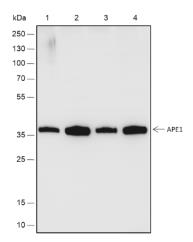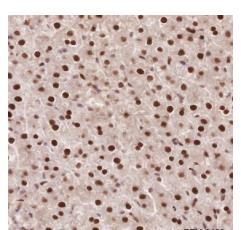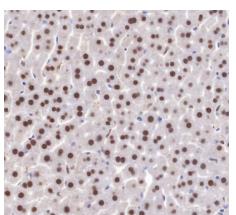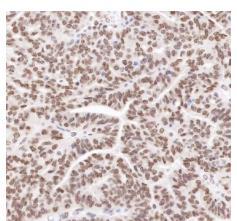
Rabbit Anti-APEX1 antibody
APEX1_HUMAN; DNA-(apurinic or apyrimidinic site) endonuclease; EC:3.1.11.2; APE; APE1; APEX; APX; HAP1; REF1; APEX nuclease (APEN); Apurinic-apyrimidinic endonuclease 1 (AP endonuclease 1; APE-1); REF-1; Redox factor-1; DNA-(apurinic or apyrimidinic site)
View History [Clear]
Details
Product Name APEX1 Chinese Name 多功能DNA修复酶Recombinant rabbit monoclonal anti Alias APEX1_HUMAN; DNA-(apurinic or apyrimidinic site) endonuclease; EC:3.1.11.2; APE; APE1; APEX; APX; HAP1; REF1; APEX nuclease (APEN); Apurinic-apyrimidinic endonuclease 1 (AP endonuclease 1; APE-1); REF-1; Redox factor-1; DNA-(apurinic or apyrimidinic site) endonuclease, mitochondrial; Research Area Cardiovascular Chromatin and nuclear signals transcriptional regulatory factor Epigenetics Immunogen Species Rabbit Clonality Monoclonal Clone NO. R2D12 React Species (predicted: Human, Mouse, Rat, ) Applications WB=1:1000-5000 IHC-P=1:100-500 IHC-F=1:200-500 (Paraffin sections need antigen repair)
not yet tested in other applications.
optimal dilutions/concentrations should be determined by the end user.Theoretical molecular weight 36kDa Cellular localization The nucleus cytoplasmic Form Liquid Concentration 1mg/ml immunogen KLH conjugated synthetic peptide derived from human APEX1 Lsotype IgG Purification affinity purified by Protein A Buffer Solution 0.01M TBS(pH7.4) with 1% BSA, 0.03% Proclin300 and 50% Glycerol. Storage Shipped at 4℃. Store at -20 °C for one year. Avoid repeated freeze/thaw cycles. Attention This product as supplied is intended for research use only, not for use in human, therapeutic or diagnostic applications. PubMed PubMed Product Detail The APEX gene encodes the major AP endonuclease in human cells. It encodes the APEX endonuclease, a DNA repair enzyme with apurinic/apyrimidinic (AP) activity. Such AP activity sites occur frequently in DNA molecules by spontaneous hydrolysis, by DNA damaging agents or by DNA glycosylases that remove specific abnormal bases. The AP sites are the most frequent pre-mutagenic lesions that can prevent normal DNA replication. Splice variants have been found for this gene; all encode the same protein. Disruptions in the biological functions related to APEX are associated with many various malignancies and neurodegenerative diseases.[provided by RefSeq, Dec 2019]
Subcellular Location:
Nucleus. Nucleus, nucleolus. Nucleus speckle. Endoplasmic reticulum. Cytoplasm. Note=Detected in the cytoplasm of B-cells stimulated to switch. Colocalized with SIRT1 in the nucleus. Colocalized with YBX1 in nuclear speckles after genotoxic stress. Together with OGG1 is recruited to nuclear speckles in UVA-irradiated cells. Colocalized with nucleolin and NPM1 in the nucleolus. Its nucleolar localization is cell cycle dependent and requires active rRNA transcription. Colocalized with calreticulin in the endoplasmic reticulum. Translocation from the nucleus to the cytoplasm is stimulated in presence of nitric oxide (NO) and function in a CRM1-dependent manner, possibly as a consequence of demasking a nuclear export signal (amino acid position 64-80). S-nitrosylation at Cys-93 and Cys-310 regulates its nuclear-cytosolic shuttling. Ubiquitinated form is localized predominantly in the cytoplasm.
DNA-(apurinic or apyrimidinic site) lyase, mitochondrial: Mitochondrion. Note=The cleaved APEX2 is only detected in mitochondria. Translocation from the cytoplasm to the mitochondria is mediated by ROS signaling and cleavage mediated by granzyme A. Tom20-dependent translocated mitochondrial APEX1 level is significantly increased after genotoxic stress.
SWISS:
P27695
Gene ID:
328
Database links:
Entrez Gene: 328 Human
Entrez Gene: 11792 Mouse
SwissProt: P27695 Human
SwissProt: P28352 Mouse
Product Picture
Primary Ab dilution: 1:5000
Primary Ab incubation condition: 2 hours at
room temperature
Secondary Ab: Goat Anti-Rabbit IgG H&L
(HRP)
Lysate: 1: HEK-293, 2: HepG2, 3: NIH/3T3, 4:
RAW264.7
Protein loading quantity: 20 μg
Exposure time: 60 s
Predicted MW: 35 kDa
Observed MW: 37 kDa
Tissue: Rat liver
Section type: Formalin-fixed & Paraffin -
embedded section
Retrieval method: High temperature and high
pressure
Retrieval buffer: Tris/EDTA buffer, pH 9.0
Primary Ab dilution: 1:1000
Primary Ab incubation condition: 1 hour at
room temperature
Secondary Ab: Anti-Rabbit and Mouse
Polymer HRP (Ready to use)
Counter stain: Hematoxylin (Blue)
Comment: Color brown is the positive signal
for SLM-60707R
Tissue: Mouse liver
Section type: Formalin-fixed & Paraffin -
embedded section
Retrieval method: High temperature and high
pressure
Retrieval buffer: Tris/EDTA buffer, pH 9.0
Primary Ab dilution: 1:1000
Primary Ab incubation condition: 1 hour at
room temperature
Secondary Ab: Anti-Rabbit and Mouse
Polymer HRP (Ready to use)
Counter stain: Hematoxylin (Blue)
Comment: Color brown is the positive signal
for SLM-60707R
Tissue: Human ovarian carcinoma
Section type: Formalin-fixed & Paraffin -
embedded section
Retrieval method: High temperature and high
pressure
Retrieval buffer: Tris/EDTA buffer, pH 9.0
Primary Ab dilution: 1:1000
Primary Ab incubation condition: 1 hour at
room temperature
Secondary Ab: Anti-Rabbit and Mouse
Polymer HRP (Ready to use)
Counter stain:
Hematoxylin (Blue)
Comment: Color brown is the positive signal
for SLM-60707R
Bought notes(bought amounts latest0)
No one bought this product
User Comment(Total0User Comment Num)
- No comment






 +86 571 56623320
+86 571 56623320
 +86 18668110335
+86 18668110335

